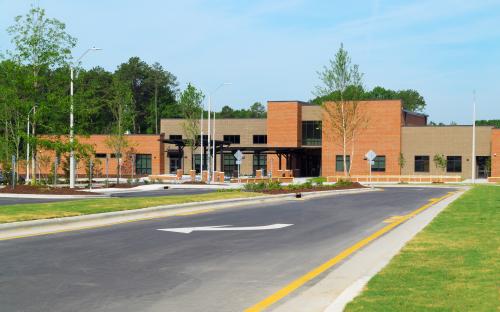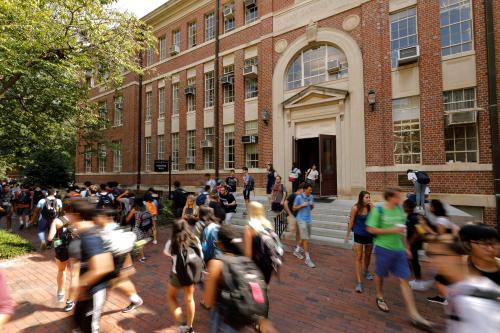Many kids grow up thinking their teachers live at school. Children become stupefied at the sight of their teacher at a grocery store or a restaurant. They can’t fathom their teachers having lives outside of the schoolhouse. Kids’ parents, on the other hand, may be shocked to learn that many teachers can’t afford to live near the schools in which they teach.
This March, Democratic presidential candidate Sen. Kamala Harris of California announced a plan to increase teacher salaries, which have not kept pace with the cost of living. Teachers’ pay is also out of line with that of other professionals. Teachers earn 11.1% less than other workers with comparable education and experience, according to the nonprofit think tank the Economic Policy Institute. Harris’ proposal would raise teachers’ salaries over the next decade to help close gaps between what teachers earn and the cost of living.
The purchasing power of teachers’ annual earnings varies greatly across the country. In 2017, the median state for teacher pay was Delaware, where P-12 teachers earned an average annual wage of $56,540 (adjusted for statewide cost of living). Teacher salaries that year were the lowest in Hawaii, with an average adjusted salary of $44,887. Rhode Island teachers had the highest adjusted earnings—$69,911.

In the San Francisco metropolitan area, where Harris formerly served as the district attorney, P-12 teachers earn $67,138 on average—a figure solidly in the upper end of the distribution for teachers nationwide. However, many teachers still struggle to live close to the community they serve, where the median rent in the area is over $20,000 per year according to 2017 census estimates. Those who do live locally can expect to spend as much as 70% of their income on housing. That amount far exceeds the 50% measure that the government defines as severely cost-burdened, meaning the monthly cost of housing makes it difficult to pay for necessities. The situation is so serious that Bay Area officials have proposed constructing low-cost housing units specifically for teachers and other school employees.
Teachers earn 11.1% less than other workers with comparable education and experience.
Homeownership in California is even more inaccessible on a teacher’s salary. A typical measure of housing affordability is the price-to-income ratio, comparing local home values to local incomes. The typical rule-of-thumb for buyers, based on the historical median, is that a ratio of 2.6 or lower is what they should consider affordable. While values can vary greatly over metro areas, if we consider instead a “price-to-teacher’s-income ratio”, it becomes clear that the typical new homeowner in California’s largest metro areas must earn many times that of a local teacher’s salary.

Last year, Miami-Dade housing and education officials sought an interesting way to close the cost of living gap with a proposal to build a middle school with one floor designated as teacher housing.
But living in teacher dorms shouldn’t be a part of the job description. Educators are vital to the overall economic wellbeing of the country. We need to increase their pay in a way that doesn’t involve turning schools into housing shelters. But is the proposed infusion of federal cash the answer?
Harris’ plan calls for each state to establish goals for teachers’ base pay. For every $1 a state invests in raising teachers’ salaries to meet that goal, the federal government would put in $3 until the pay gap between teachers’ current salary and the goal salary is closed. Teachers who work in high-need schools, often attended by a disproportionate number of students of color, would receive a greater raise, aiding teacher recruitment and retention efforts. Over the course of 10 years under Harris’ plan, teachers would receive a raise of $13,500 on average, an increase of 23%. The plan also calls for investment of funds in the teaching profession. Half of these designated federal funds would go to teacher training programs at “minority-serving institutions,” including historically black colleges and Hispanic serving institutions, where many black and brown teacher candidates are educated.
Educators are vital to the overall economic wellbeing of the country. We need to increase their pay in a way that doesn’t involve turning schools into housing shelters.
Consultants who worked on the plan estimate its total cost at $315 billion. Harris says the funding will come from an increase in the estate tax for the top 1 percent. The federal estate tax, which only affects the very wealthy, is levied on property—including cash, real estate, trusts, and other assets—that is transferred from the deceased to their heirs. The tax only applies to assets valued beyond a level set by the IRS. Since 2001, that exemption level has increased from $675,000 to $11.4 million. As a result, those inheriting millions in property often pay the same amount as those who don’t have inheritances: nothing at all. Harris plans to close this loophole, and others exploited by the rich, and support teachers along the way.
Harris’ plan is novel and by far the boldest effort to address diminishing teacher pay, a hot-button issue that in the last two years has motivated teachers across the country to go on strike. Harris will no doubt attract attention from teachers, and particularly from the more than 75% of the profession who are women.
However, even if the federal government helped pay for higher teacher salaries, states might be hesitant to take the cash. Salary levels are used to determine retirement, health and other benefits that states and districts are still on the hook to pay for. States may find themselves unable to take the federal funds if it means having to raise revenue to pay for related benefits. In addition, many states have grown tired of federal intervention. In 2015 the federal Every Student Succeeds Act (ESSA) was drafted in a bipartisan fashion, but when federal attempts to improve schools appeared to encroach upon state control of education, both parties bucked President Obama’s reform efforts, which included the Race to the Top initiative designed to stimulate education reform.
Teachers need raises, and I welcome creative efforts to get them, but federal cash is not a simple, quick fix. Based on the results of most of the statewide strikes, mobilization seems to be an effective strategy to force states to increase pay. Harris can actually do a lot from her federal Senate seat to reduce state spending on line items that crowd state budgets: she can help curb rising health care and criminal justice costs that burden states.
What’s clear is that Harris’ proposal brings much-needed attention to the problem of teacher pay. Something must be done. Kids grow up thinking their teachers live at school. Let’s not let that become the only option available.
The Brookings Institution is committed to quality, independence, and impact.
We are supported by a diverse array of funders. In line with our values and policies, each Brookings publication represents the sole views of its author(s).







Commentary
Too many teachers can’t afford to live near their schools
June 20, 2019